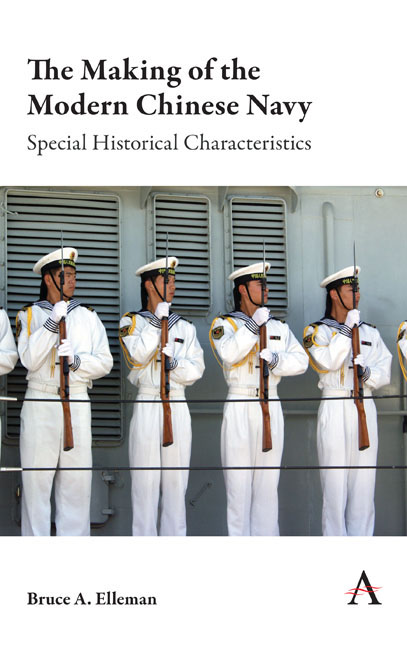Book contents
- Frontmatter
- Contents
- Introduction: The Special Characteristics of China's Maritime History
- 1 Battle of Bạch Đăng River (938)
- 2 Battle of Yaishan (1279)
- 3 Battle of Lake Poyang (1363)
- 4 Ming–Kotte War in Southeast Asia (1410–11)
- 5 Ming Loyalists Flee to Taiwan (1661–83)
- 6 Battle of Chuanbi (1839)
- 7 Sino-French War (1884–85)
- 8 Qing Beiyang Fleet's Defeat in the Battle of the Yellow Sea (1894)
- 9 Chinese Decision to Sink The Nationalist Navy as Blockships (1937)
- 10 Chongqing Mutiny Allowing the PLA to Cross the Yangzi River (1949)
- 11 The Taiwan Strait Crises (1954–55 and 1958)
- 12 China's Decision to Take the Paracel Islands from South Vietnam (1974)
- 13 Missile Blockade: The Taiwan Strait Crisis (1995–96)
- 14 The EP-3 Standoff and Diplomatic Resolution (2001)
- Conclusions: The Influence of History on the Formation of a Modern Chinese Navy
- Selected Bibliography
- Index
3 - Battle of Lake Poyang (1363)
Published online by Cambridge University Press: 04 October 2019
- Frontmatter
- Contents
- Introduction: The Special Characteristics of China's Maritime History
- 1 Battle of Bạch Đăng River (938)
- 2 Battle of Yaishan (1279)
- 3 Battle of Lake Poyang (1363)
- 4 Ming–Kotte War in Southeast Asia (1410–11)
- 5 Ming Loyalists Flee to Taiwan (1661–83)
- 6 Battle of Chuanbi (1839)
- 7 Sino-French War (1884–85)
- 8 Qing Beiyang Fleet's Defeat in the Battle of the Yellow Sea (1894)
- 9 Chinese Decision to Sink The Nationalist Navy as Blockships (1937)
- 10 Chongqing Mutiny Allowing the PLA to Cross the Yangzi River (1949)
- 11 The Taiwan Strait Crises (1954–55 and 1958)
- 12 China's Decision to Take the Paracel Islands from South Vietnam (1974)
- 13 Missile Blockade: The Taiwan Strait Crisis (1995–96)
- 14 The EP-3 Standoff and Diplomatic Resolution (2001)
- Conclusions: The Influence of History on the Formation of a Modern Chinese Navy
- Selected Bibliography
- Index
Summary
Small navies can often defeat large ones. Before the Ming dynasty could overthrow Mongol rule in China, it first had to defeat the other Han Chinese states rivaling it for power. The main battlefield was not on a river or at sea but was on one of China's largest fresh water lakes. The battle of Lake Poyang was fought from August 30– October 4, 1363 in Jiangxi province. The Ming fleet separated into squadrons, with the heavier ships at the center, and made a frontal assault on the Han ships. The Ming ships were lighter and smaller compared to the Han ships. By using fireships many Han ships were either damaged or destroyed. The Ming then blockaded the Han fleet for a month. On October 4, the final battle began. The Ming again employed fireships. In the midst of fighting, the Han leader Chen Youliang was killed, and the Han surrendered. The Ming victory unified opposition to the Mongols, which five years later resulted in the collapse of the Yuan dynasty in 1368.
Summary of the Battle of Lake Poyang
The Battle of Lake Poyang illustrates that a navy's size is not the only factor in warfare. Described as one of the largest naval battles in world history up until this time, this conflict pitted Zhu Yuanzhang, the founder of the Ming dynasty, against the Han state commander Chen Youliang. At this point, the Mongols continued to rule China as the Yuan dynasty. A number of Han Chinese breakaway states, however, sought to consolidate resistance to the Mongols. The crucial battle occurred on Poyang Lake, the largest Chinese freshwater lake at that time, located in Jiangxi province just south of the Yangzi River.
The Han state initiated fighting when it attacked Nanchang, which was under the control of the Ming state. When the city resisted, fighting on Lake Poyang became the main focus of the conflict. The Ming fleet was made up of many small ships divided into 11 squadrons, while the Han fleet was composed of large ships (known as “tower ships” or lou chuan). While normally the larger fleet could easily dominate the smaller one, the water in Lake Poyang was at its normally low seasonal level, which allowed the smaller and more nimble ships to dominate fighting in shallow waters.
- Type
- Chapter
- Information
- The Making of the Modern Chinese NavySpecial Historical Characteristics, pp. 17 - 20Publisher: Anthem PressPrint publication year: 2019



